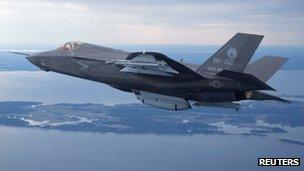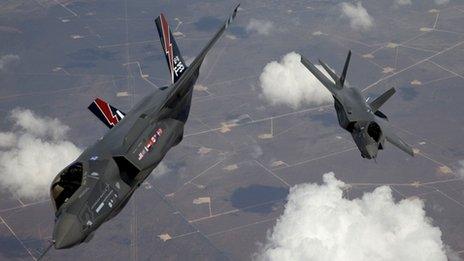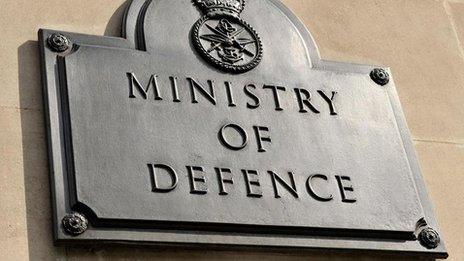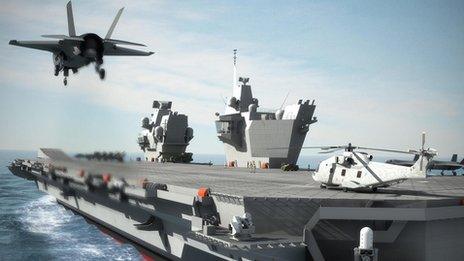Why did coalition government change fighter plane plan?
- Published
- comments

The cost of the U-turn is likely to be about £100m
The kindest way of describing the government's U-turn over its new F35 fighter fleet is to point out that it should never have rushed to decide on the subject back in its Strategic Defence and Security Review or SDSR of October 2010.
Today a defence source conceded, "it's taken 18 months to figure out all of the detail".
Several factors have combined to today's decision to buy a short take-off and vertical landing version of the plane (the F-35B) rather than the more capable F-35C variant that would have required catapults to hurl it skywards.
The cost of launching and catching the latter type is now estimated at £2bn for the Prince of Wales, and an additional £3bn if the Royal Navy wanted to adapt the first ship of this type, the Queen Elizabeth for this type of operation.
In the current public spending climate, it's hardly surprising that the government has ducked the decision to spend £5bn to gain this capability.
Instead, it will use the F35B, which will use a ski jump type take off ramp much like the now retired Harrier, and the first operational carrier will be available, says the MoD, in 2018 rather than 2025.
So if the decision to use the short take off version of the jet makes sense, why on earth did the incoming coalition government decide to change the plan?
'Wrong way'
David Cameron, in launching the SDSR, said that switching to the F-35C had to happen because, "there is only one thing worse than spending money you don't have and that is buying the wrong things with it and doing so in the wrong way."
Many people said at the time of the SDSR that it was a rushed exercise. Certainly it is now clear that the work done on the cost implications of retiring the Harrier force and replacing it (after a gap of many years) with F-35C was quite inadequate.
Speaking privately to those who were party to some of the decision making, one hears less kind explanations of what has happened. One senior naval figure calls it, "a hopeless shambles".
The key axis in the government's mistake of October 2010 appears to have been that between Downing Street and the RAF.
Liam Fox, the defence secretary at the time, had ordered that his review should retire one major type of combat aircraft in order to save money. Fairly soon the choice narrowed to one between the Harrier and Tornado.
Senior RAF officers saw the possible disappearance of the Tornado, which is the last vestige of the service's wartime Bomber Command, as a threat to the future existence of their service.
They argued strongly for the Harrier to get the chop instead, and succeeded creating the carrier gap, since no replacement could be ready quickly.
'Grown up carrier'
Downing Street, it seems, wanted some positive headlines out of the SDSR, which was largely an exercise in cutbacks, so it decided to back the idea of Britain getting a "grown up" aircraft carrier, ie one launching conventional aircraft with catapults rather than a very large replacement "Harrier Carrier". It therefore stressed the ineffectiveness of the F-35C.
The die was cast. Although the government never quite specified what would happen to the Queen Elizabeth if the Prince of Wales was fitted with highly expensive "cats and traps" for the more capable fighter, there was a strong presumption that it would be mothballed or sold, leaving the country with one carrier, able to provide cover around 60% of the time.
Now Britain has decided that "grown up" is unaffordable, senior naval officers hope that it will at least mean both ships are put into service, allowing the country to have one of these ships available at all times (in case, for example the other is in refit).
But today the government has not given any commitment to deploy both vessels, and it seems quite likely that the nation's huge investment in ships and planes will produce a one carrier "force" with a less capable jet.
- Published10 May 2012

- Published21 April 2012

- Published19 March 2012
